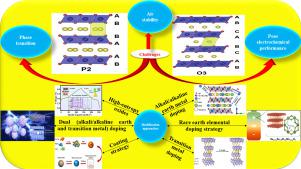当前位置:
X-MOL 学术
›
Renew. Sust. Energ. Rev.
›
论文详情
Our official English website, www.x-mol.net, welcomes your
feedback! (Note: you will need to create a separate account there.)
Recent progress of layered structured P2- and O3- type transition metal oxides as cathode material for sodium-ion batteries
Renewable and Sustainable Energy Reviews ( IF 16.3 ) Pub Date : 2023-12-26 , DOI: 10.1016/j.rser.2023.114167
Yamini Gupta , Poonam Siwatch , Reetika Karwasra , Kriti Sharma , S.K. Tripathi
Renewable and Sustainable Energy Reviews ( IF 16.3 ) Pub Date : 2023-12-26 , DOI: 10.1016/j.rser.2023.114167
Yamini Gupta , Poonam Siwatch , Reetika Karwasra , Kriti Sharma , S.K. Tripathi

|
The demand for grid-scale energy storage devices is increasing extensively nowadays. However, existing energy storage devices, consisting of Nickel-cadmium batteries, Lithium-ion batteries, and Nickel-metal hydride batteries, cannot meet future demands due to irregular dispersal and the high price of the reserves. In this regard, sodium-ion batteries (SIBs) that utilize Na-ions in their charge storage mechanism have gained significant consideration due to price advantage and extensive dispersal of sodium reserves in the earth’s crust. Due to its significant effect on the electrochemical performance, the cathode materials are considered a key component for SIBs. Up to now, Polyanionic compounds, Prussian blue analogues, Organic materials, and Layered transition metal oxides (LTMOs) have been investigated as cathode materials for SIBs. LTMOs are considered potential cathode materials for SIBs due to their feasible synthesis, excellent specific capacity, and environmental friendliness. Layered P2- and O3- types are found to be promising candidates for their use as cathode material in SIBs commercialization. This review features the current development in LTMOs (mainly P2- and O3- types) as cathode candidates for SIBs, their synthesis techniques, the present challenges faced by this technology, modification approaches to enhance the electrochemical performance, and future aspects of developing fully functional SIBs.
中文翻译:

层状结构P2型和O3型过渡金属氧化物钠离子电池正极材料研究进展
如今,对电网规模储能装置的需求广泛增长。然而,现有的镍镉电池、锂离子电池、镍氢电池等储能装置由于分布不规则、储量价格昂贵,无法满足未来的需求。在这方面,由于价格优势和钠储量在地壳中的广泛分布,在电荷存储机制中利用钠离子的钠离子电池(SIB)已受到广泛关注。由于其对电化学性能的显着影响,正极材料被认为是SIB的关键组成部分。到目前为止,聚阴离子化合物、普鲁士蓝类似物、有机材料和层状过渡金属氧化物(LTMO)已被研究作为SIB的阴极材料。 LTMOs因其合成可行、优异的比容量和环境友好性而被认为是SIBs的潜在正极材料。层状 P2 和 O3 类型被发现是在 SIB 商业化中用作阴极材料的有前途的候选者。本综述重点介绍了作为 SIB 阴极候选材料的 LTMO(主要是 P2 型和 O3 型)的当前发展、其合成技术、该技术目前面临的挑战、增强电化学性能的改性方法以及开发全功能的未来方面SIB。
更新日期:2023-12-26
中文翻译:

层状结构P2型和O3型过渡金属氧化物钠离子电池正极材料研究进展
如今,对电网规模储能装置的需求广泛增长。然而,现有的镍镉电池、锂离子电池、镍氢电池等储能装置由于分布不规则、储量价格昂贵,无法满足未来的需求。在这方面,由于价格优势和钠储量在地壳中的广泛分布,在电荷存储机制中利用钠离子的钠离子电池(SIB)已受到广泛关注。由于其对电化学性能的显着影响,正极材料被认为是SIB的关键组成部分。到目前为止,聚阴离子化合物、普鲁士蓝类似物、有机材料和层状过渡金属氧化物(LTMO)已被研究作为SIB的阴极材料。 LTMOs因其合成可行、优异的比容量和环境友好性而被认为是SIBs的潜在正极材料。层状 P2 和 O3 类型被发现是在 SIB 商业化中用作阴极材料的有前途的候选者。本综述重点介绍了作为 SIB 阴极候选材料的 LTMO(主要是 P2 型和 O3 型)的当前发展、其合成技术、该技术目前面临的挑战、增强电化学性能的改性方法以及开发全功能的未来方面SIB。

































 京公网安备 11010802027423号
京公网安备 11010802027423号